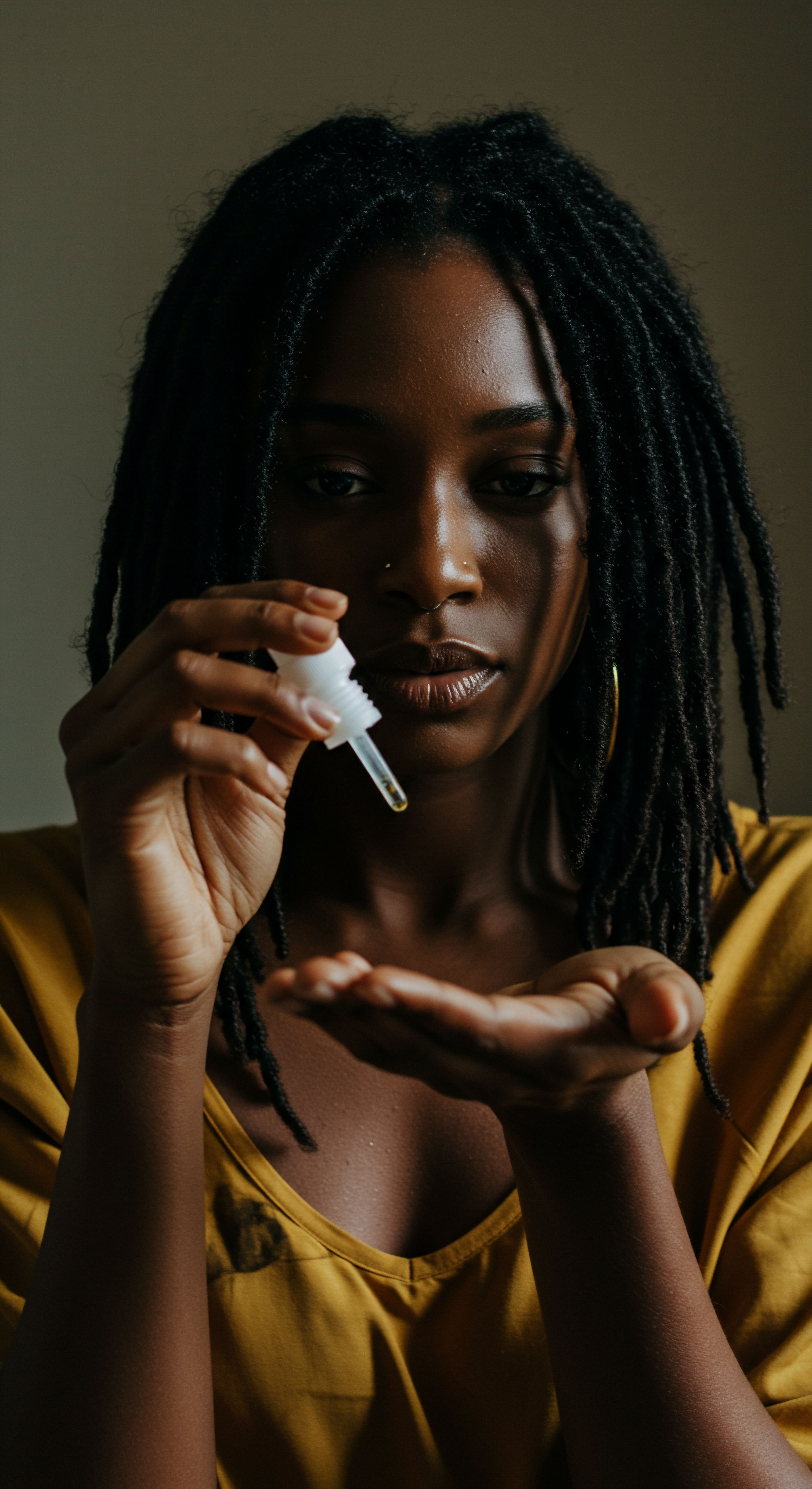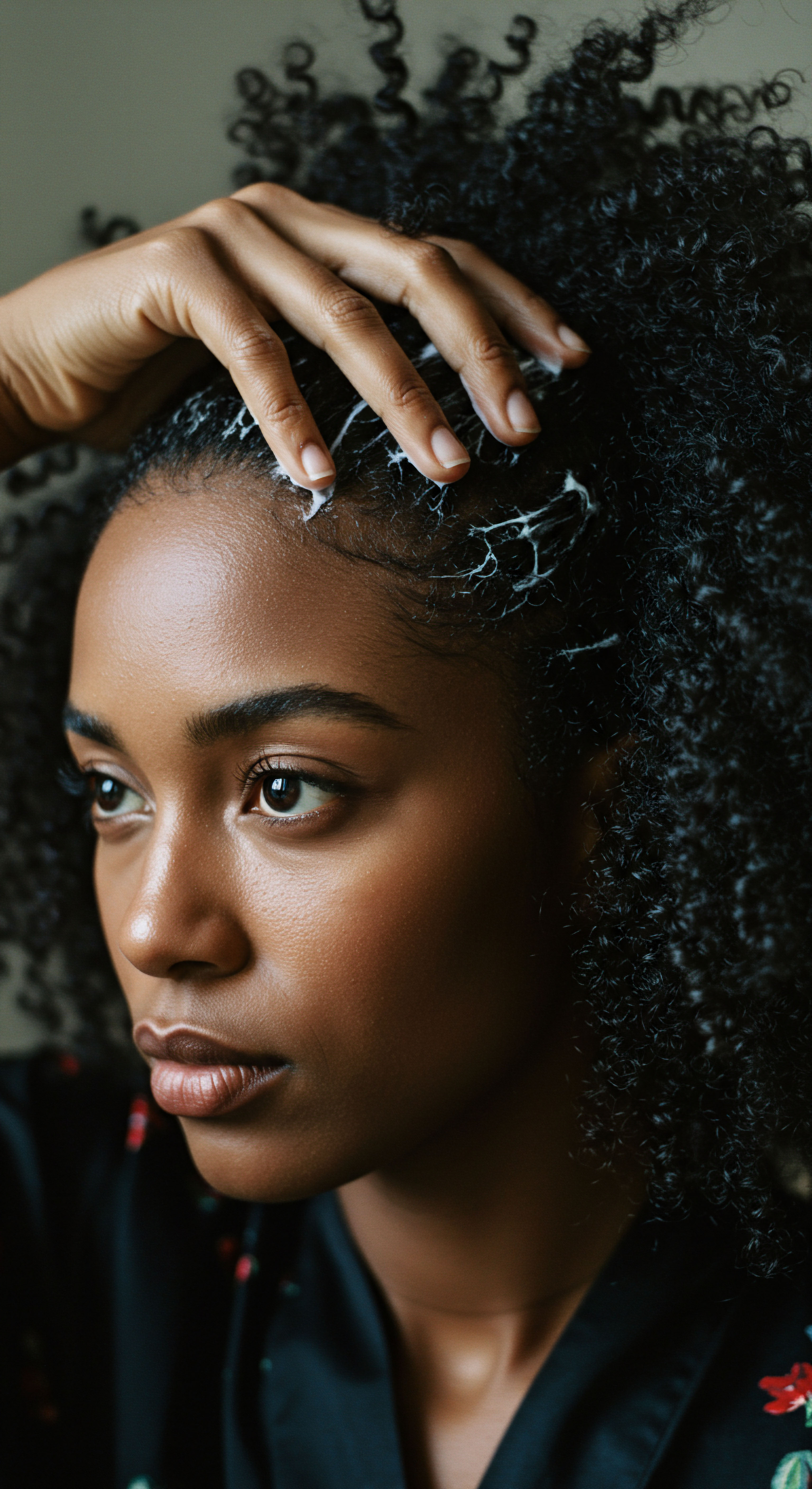
Roots
The quiet hum of fingers moving through textured strands, a rhythm passed down through generations, holds within its cadence more than just styling secrets. It whispers tales of community, of belonging, and of a deep, abiding connection that transcends mere aesthetics. For ancient African societies, hair braiding was seldom a solitary act performed in isolation.
It was a communal ritual, a shared moment that wove individuals into the collective spirit of their people. This intimate practice created a unique space where social structures were reinforced, wisdom was imparted, and personal narratives found their place within the grand story of the clan.
The very act of braiding demanded time, patience, and close physical proximity. In societies where oral tradition reigned supreme, these hours spent in shared physical space became invaluable arenas for cultural transmission. Elders, often the primary braiders, could recount histories, share proverbs, and teach life lessons, their words flowing as steadily as their skilled hands.
Younger generations absorbed these teachings not just through listening, but through the tangible experience of touch and the shared focus on a common task. This embodied learning solidified cultural values and reinforced the intergenerational transfer of knowledge, making the braid a living library of heritage.

What Did Hair Braiding Represent in Ancient African Societies?
Hair, in many ancient African cultures, held immense symbolic weight. It was seen as a conduit to the divine, a marker of identity, and a reflection of one’s spiritual and social standing. The styles themselves were far from arbitrary; they communicated intricate messages about a person’s age, marital status, wealth, social rank, and even their village or ethnic group.
A glance at a person’s coiffure could reveal their life story and their place within the community. This visual language created a profound sense of shared understanding and recognition among community members, acting as a visible manifestation of social cohesion.
Ancient African hair braiding served as a vibrant, living language, visually communicating identity and societal roles.
The preparation for braiding was itself a communal affair. Gathering specific herbs, oils, and tools, often from local sources, could involve collective effort. This initial stage set the precedent for the shared experience to follow, grounding the practice in the immediate environment and the collective labor of the group. The resources used were not just for hair; they were often medicinal or spiritually significant, connecting the physical act of grooming to broader aspects of well-being and spiritual alignment.

How Did Shared Grooming Shape Social Hierarchies?
While braiding fostered a sense of unity, it also subtly reinforced societal structures. Specialized braiders, often revered for their artistic skill and knowledge of complex patterns, held positions of respect. Their services might be sought by community leaders or those preparing for significant life events, further solidifying their role as cultural custodians.
The act of being braided by such a skilled artisan could itself be a status symbol, indicating access to valuable community resources and expertise. This system, rather than creating division, often reinforced a stable social order, with each member understanding their place and contribution within the collective.
- Cultural Identity ❉ Braids distinguished ethnic groups and communicated belonging.
- Social Status ❉ Certain styles indicated age, marital status, or leadership roles.
- Intergenerational Transfer ❉ Elders passed down wisdom during braiding sessions.
The shared vulnerability of sitting for hours, entrusting one’s hair to another’s hands, cultivated a unique intimacy. This physical closeness fostered open conversation, allowing for the exchange of confidences, advice, and emotional support. It was a safe space where individuals could voice concerns, celebrate joys, and collectively process challenges, strengthening the emotional fabric of the community. This ritualistic interaction built trust and mutual reliance, laying a firm foundation for communal resilience.
| Function Category Communication |
| Specific Impact Conveyed social standing, marital status, age, and tribal affiliation. |
| Function Category Education |
| Specific Impact Served as a platform for oral histories and traditional teachings. |
| Function Category Community Building |
| Specific Impact Created shared physical and emotional spaces for bonding. |
| Function Category Spiritual Connection |
| Specific Impact Linked individuals to ancestral practices and beliefs. |
| Function Category Braiding integrated personal and collective identity within a rich cultural context. |

Ritual
Stepping from the foundational significance of ancient African hair practices, we arrive at the deliberate, repeated actions that elevated braiding from a simple grooming task to a profound social ritual. These were not random occurrences but purposeful gatherings, often imbued with a sense of ceremony, even in their daily execution. The anticipation of a braiding session, the gathering of family or friends, and the quiet concentration of the braider and the braided alike, all contributed to an atmosphere of shared purpose and connection. This section explores the mechanics of how these recurring rituals actively built and maintained social ties, moving beyond mere recognition to active participation.
The ritualistic aspect of hair braiding extended beyond the physical act itself. It often coincided with significant life events, marking transitions and milestones. Braids for rites of passage, for weddings, for mourning, or for celebrating victories all served to collectively acknowledge and process these moments.
By participating in the creation of these symbolic hairstyles, community members reaffirmed their collective identity and their support for the individual undergoing the transition. The hair became a tangible record of these shared experiences, a living memory etched onto the head.

How Did Braiding Sessions Shape Communal Gatherings?
The typical braiding session was a microcosm of community life. It was a space where conversations flowed freely, laughter mingled with serious discussion, and advice was sought and given. Children observed silently, absorbing the dynamics of adult interaction and the artistry of the hands at work.
This observational learning was a vital component of cultural transmission, preparing them for their future roles within the social fabric. The informal setting allowed for genuine connection, often breaking down typical social barriers and fostering a more egalitarian exchange among participants.
The rhythmic process of braiding cultivated a sacred space for shared narratives and communal understanding.
The duration of a complex braiding style could span many hours, sometimes even days, requiring multiple people to contribute to its completion. This extended period necessitated cooperation and mutual reliance. The person whose hair was being braided had to sit still, trusting the hands at work.
The braiders had to coordinate their efforts, often working in tandem to achieve the desired intricate pattern. This shared endeavor fostered a deep sense of collective achievement and interdependence, reinforcing the idea that the community’s well-being relied on individual contributions and harmonious collaboration.

What Role Did Reciprocity Play in Braiding Traditions?
Reciprocity was a fundamental aspect of these rituals. While some braiders were highly skilled specialists, many communities practiced a form of mutual aid where individuals would braid each other’s hair. This exchange of services, often without direct monetary payment, solidified bonds of friendship and kinship.
It was an unspoken agreement of support and care, a tangible expression of community solidarity. This system of reciprocal gifting extended beyond hair, mirroring the broader social contract of mutual support that underpinned many ancient African societies.
- Shared Time ❉ Extended braiding sessions facilitated deep conversations and bonding.
- Skill Exchange ❉ Reciprocal braiding strengthened ties of mutual aid and support.
- Life Event Marking ❉ Specific styles commemorated rites of passage and celebrations.
The tools and materials used in these rituals were often imbued with cultural significance. Combs carved from specific woods, beads fashioned from local resources, or natural oils derived from indigenous plants all connected the practice to the land and its spiritual properties. The preparation and application of these elements were themselves part of the ritual, connecting the individuals to their environment and their ancestral practices. The very touch of these natural elements, combined with the human touch of the braider, created a multi-sensory experience that deepened the ritual’s impact.
| Element Time Investment |
| Social Implication Promoted sustained social interaction and conversation. |
| Element Physical Proximity |
| Social Implication Cultivated intimacy and personal connection. |
| Element Shared Task |
| Social Implication Fostered cooperation and collective accomplishment. |
| Element Symbolic Materials |
| Social Implication Connected individuals to their land and heritage. |
| Element These elements combined to form powerful, recurring social reinforcements. |

Relay
Having explored the foundational and ritualistic dimensions of ancient African hair braiding, we now consider its role as a powerful relay mechanism, transmitting not only physical artistry but also the very scaffolding of social cohesion across time and space. This goes beyond simple communication; it speaks to the deep, almost subconscious ways in which the act of braiding facilitated collective cognition, shared emotional states, and the perpetuation of complex societal structures. It was a dynamic, living system for the propagation of culture, resilience, and identity.
The physical act of braiding, often involving sustained, gentle touch, had a demonstrable impact on interpersonal connection at a neurobiological level. Research into human social behavior indicates that non-sexual, affiliative touch can prompt the release of oxytocin, a neuropeptide associated with social bonding, trust, and empathy. While direct neurochemical studies on ancient African braiding practices are, of course, absent, the universality of human physiology suggests that the sustained physical contact and reciprocal grooming inherent in these sessions would have naturally fostered these bonding mechanisms.
The tactile experience was not merely incidental; it was a biological underpinning of the social strengthening that occurred. This scientific perspective offers a profound layer of understanding to the deep social ties observed in these communities.

How Did Braiding Facilitate Shared Cognition and Group Identity?
The intricate patterns created through braiding often served as mnemonic devices, aiding in the collective memory and transmission of complex knowledge. For instance, certain patterns might represent historical events, ancestral lineages, or even practical information like migration routes or agricultural cycles. The process of learning and replicating these designs required focused attention and shared instruction, creating a collective cognitive effort. This shared mental engagement, where individuals collaboratively constructed and interpreted meaning through the physical act of braiding, solidified a collective identity rooted in common knowledge and shared history.
Braiding acted as a profound medium for transmitting cultural knowledge and strengthening group identity through shared activity.
The cultural significance of specific braiding patterns could also extend to diplomatic or inter-group relations. A particular style might signify a treaty, an alliance, or a declaration of peace or war. When representatives from different communities met, their hairstyles could convey complex messages without a single word being spoken, acting as a non-verbal diplomatic language. This allowed for immediate recognition of status, intent, and affiliation, streamlining social interactions and fostering a more predictable, and thus more stable, social environment between distinct groups.

Can Braiding Be Seen as a Form of Collective Resistance?
Beyond direct social bonds within a community, hair braiding also served as a powerful tool for collective resistance, particularly during periods of external oppression, such as the transatlantic slave trade. Enslaved Africans, stripped of their names, languages, and traditional attire, often maintained their hair traditions in secret. Braids were not only a way to retain a connection to their heritage but also a practical means of survival. Rice grains and seeds were hidden within intricate braids, providing sustenance and the means to cultivate new crops upon escape.
This covert use of braiding created a hidden network of solidarity and shared defiance among those suffering, a silent act of rebellion that reinforced communal bonds under extreme duress. The very act of preserving these practices, despite brutal attempts at erasure, became a testament to an enduring spirit and a collective commitment to identity.
Consider the example of the Fugitive Slave Act of 1850 in the United States , which intensified efforts to capture and return enslaved people. Despite the heightened risks, evidence suggests that enslaved individuals continued to use braiding as a clandestine method for survival and communication. For instance, patterns like the “cornrow map” are often cited as a means by which escape routes were subtly communicated and even provisions like seeds for cultivation were concealed within the hair.
This act of braiding, seemingly innocuous to outsiders, became a potent symbol of shared hope and organized resistance within the enslaved community, demonstrating an extraordinary level of collective action and trust among participants. This deep-seated reliance on shared knowledge and communal support, transmitted through a culturally significant practice, highlights how braiding could solidify bonds even in the face of existential threats.
- Covert Communication ❉ Braids concealed messages and escape routes during enslavement.
- Identity Preservation ❉ Maintaining traditional styles affirmed cultural continuity under duress.
- Shared Defiance ❉ The collective act of secret braiding strengthened bonds of resistance.
The legacy of this relay continues to influence contemporary textured hair practices. The historical context imbues modern braiding with a deeper meaning, connecting individuals to a lineage of resilience, creativity, and communal strength. Each braid, whether a simple cornrow or an elaborate twist, carries echoes of the past, serving as a reminder of the profound social function hair has always played in African and diasporic communities. This continuous flow of tradition, passed from hand to hand, from generation to generation, ensures that the social bonds forged through hair braiding remain a living heritage.
| Mechanism Neurobiological Touch |
| Impact on Social Bonds Promoted oxytocin release, fostering trust and empathy. |
| Mechanism Cognitive Mapping |
| Impact on Social Bonds Aided collective memory and transmission of complex knowledge. |
| Mechanism Non-Verbal Diplomacy |
| Impact on Social Bonds Conveyed status and intent between different groups. |
| Mechanism Collective Resistance |
| Impact on Social Bonds Facilitated covert communication and shared defiance during oppression. |
| Mechanism Braiding transmitted culture, knowledge, and solidarity across generations and circumstances. |

Reflection
The quiet dignity of a braided crown, whether seen on an ancient elder or a modern youth, speaks volumes. It is a testament to the enduring power of human connection, woven into the very fabric of identity. The story of ancient African hair braiding is a vibrant reminder that our appearance is rarely just about ourselves; it is a profound dialogue with our past, our community, and our future.
It teaches us that true beauty lies not just in what we see, but in the unseen bonds that sustain us, in the shared histories that shape us, and in the quiet strength passed from one gentle hand to another. The journey through these practices reveals a profound wisdom ❉ that the simplest acts, when imbued with cultural meaning and shared purpose, can become the most potent forces for unity.

References
- Field, T. (2010). Touch for socioemotional and physical well-being ❉ A review. Developmental Review, 30(4), 367-383.
- Griebel, H. B. (1987). The African-American woman’s hair ❉ An historical overview. Journal of American Culture, 10(3), 1-13.
- Opoku, A. A. (1997). African Traditional Religion ❉ A Study in the Belief System of the Akan. Ghana Universities Press.
- Sebanz, N. Bekkering, H. & Prinz, W. (2006). Joint action ❉ Bodies and minds moving together. Trends in Cognitive Sciences, 10(2), 70-76.
- Sweetman, R. (2007). The Cultural Politics of Hair in the African Diaspora. Routledge.
- Tomasello, M. (2014). A Natural History of Human Thinking. Harvard University Press.
- White, C. M. (2003). African-American Women and Hair ❉ A History. University of Pennsylvania Press.